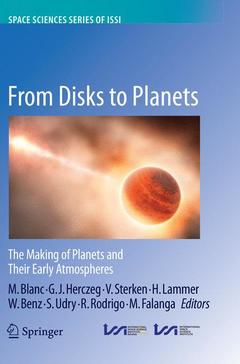Description
From Disks to Planets, Softcover reprint of the original 1st ed. 2018
The Making of Planets and Their Early Atmospheres
Space Sciences Series of ISSI Series, Vol. 56
Coordinators: Blanc Michel, Herczeg Gregory J., Sterken Veerle, Lammer Helmut, Benz Willy, Udry Stéphane, Rodrigo Rafael, Falanga Maurizio
Language: English
Subject for From Disks to Planets:
From Disks to Planets
Publication date: 01-2019
416 p. · 15.5x23.5 cm · Paperback
Publication date: 01-2019
416 p. · 15.5x23.5 cm · Paperback
From Disks to Planets
Publication date: 08-2018
Support: Print on demand
Publication date: 08-2018
Support: Print on demand
Description
/li>Contents
/li>Biography
/li>Comment
/li>
This volume discusses the evolutionary paths linking planets and their atmospheres to their origin within circumstellar disks. It reviews the main phases of this evolution, summarizes what we understand and what are the important open questions, and suggests ways towards solutions. Dust accretion within disks generates planet cores, while gas accretion on these cores leads to the diversity of their fluid envelopes. The formation of planetary proto-atmospheres and oceans is an essential product of planet formation. A fraction of the planets retain their primary proto-atmosphere, while others lose it and may form a ?secondary? atmosphere. When the disk finally dissipates, it leaves us with the combination of a planetary system and a debris disk. Using the next generation of observing facilities, we will be able to reconstruct more accurately the evolutionary paths linking stellar genesis to the possible emergence of habitable worlds.
Originally published in Space Science Reviews, Volume 205, Issue 1-4, December 2016
Preface.- Chapter 1: Introduction to Disk-Planets Relations.- Part 1: From Protoplanetary Disks to Young Planets and Their Proto-Atmospheres. Chapter 2: The Gas Disk: Evolution and Chemistry.- Chapter 3: The Dust Disk – Settling and Growth.- Chapter 4: Formation, Orbital and Internal Evolutions of Young Planetary Systems.- Chapter 5: Disk Dispersal: Theoretical Understanding and Observational Constraints.- Chapter 6: Formation and Evolution of Proto-Atmospheres.- Part 2: The Products of the Co-Evolution of Disks and Planets.- Chapter 7: Insights into Planet Formation from Debris Disks. I. The Solar System as an Archetype for Planetesimal Evolution.- Chapter 8: Insights into Planet Formation from Debris Disks. II.Giant Impacts in Extrasolar Planetary Systems.- Chapter 9: Architecture and Dynamics of Systems.- Chapter 10: Exoplanets Atmospheres.- Part 3: Future Projects and Their Scientific Perspectives.- Chapter 11: The Way Forward.
Michel Blanc was director of the Midi-Pyrenees Observatory at Toulouse and Pic-du-Midi (1988-1998) and of the Marseille Observatory (2000-2005) before being Vice-President for research of Ecole Polytechnique (2007-2012). He is presently an astronomer at IRAP (CNRS-University of Toulouse), a Discipline Scientist at the International Space Science Institute in Bern, Switzerland, and since late 2016, the Executive Director of the International Space Science Institute in Beijing, China. His works focus on space plasma physics applied to the magnetized environments of planets, particularly the Earth and the giant planets. He specializes in the exploration of giant planets systems, being an Interdisciplinary Scientist on the Cassini-Huygens mission, a co-I of the Juno mission and the lead proponent of the Laplace proposal to ESA, which led to the selection of ESA’s JUICE mission. He is the author of over 100 scientific papers and of about 50 invited talks in international conferences and gives many outreach lectures for the general audience.
Gregory Herczeg joined the Kavli Institute of Astronomy and Astrophysics (KIAA) at Peking University in 2011 as a Youth Qianren Professor. His fields of research include the evolution of protostars and pre-main sequence stars, the physics and chemistry of circumstellar disks, and the formation of planets as a product of disk evolution. He has co-authored 150 publications in refereed journals.
Dr. Veerle Sterken worked in 2007 on the Darwin mission in a joint venture between ESA, TU Delft and Thales Alenia Space (France) before she started her Ph.D. project at the Max Planck Institute for Nuclear Physics (MPIK) in 2009. There, she studied the motion of interstellar dust in the solar system and was involved in the Stardust mission. She obtained her Ph.D. degree from the TU Braunschweig in August 2012 while working at the MPIK. She first continued her work as a postdoctoral researcher in the same research group, then moved tComprehensively covers all different phases of planetary system formation under the authorship of the best experts of each phase Places the science of exoplanets in a single unifying perspective: the quest for the formation and evolution of planetary systems Makes equal use of ground and space-based observation as well as the most advanced modelling tools available
© 2024 LAVOISIER S.A.S.




